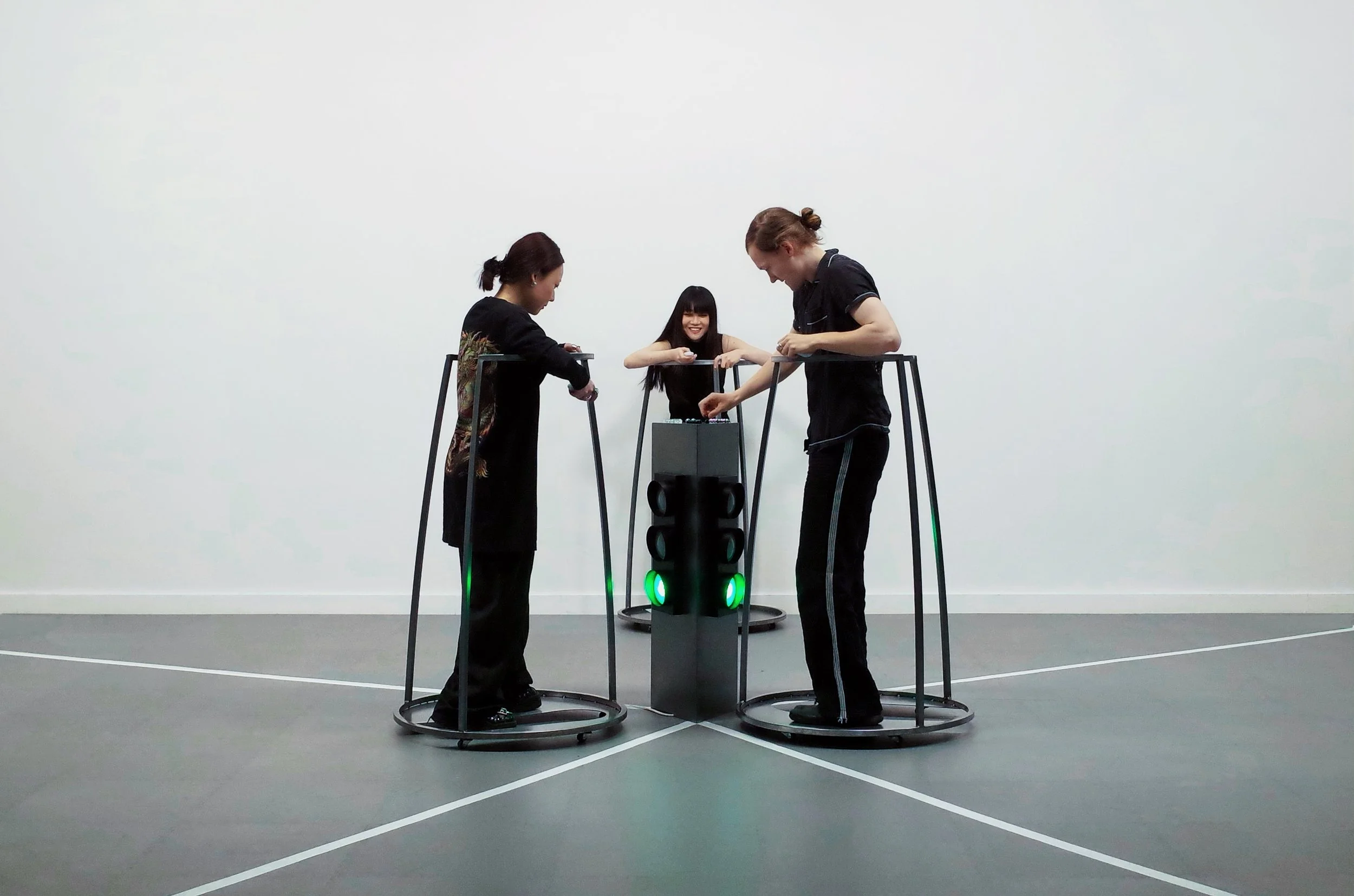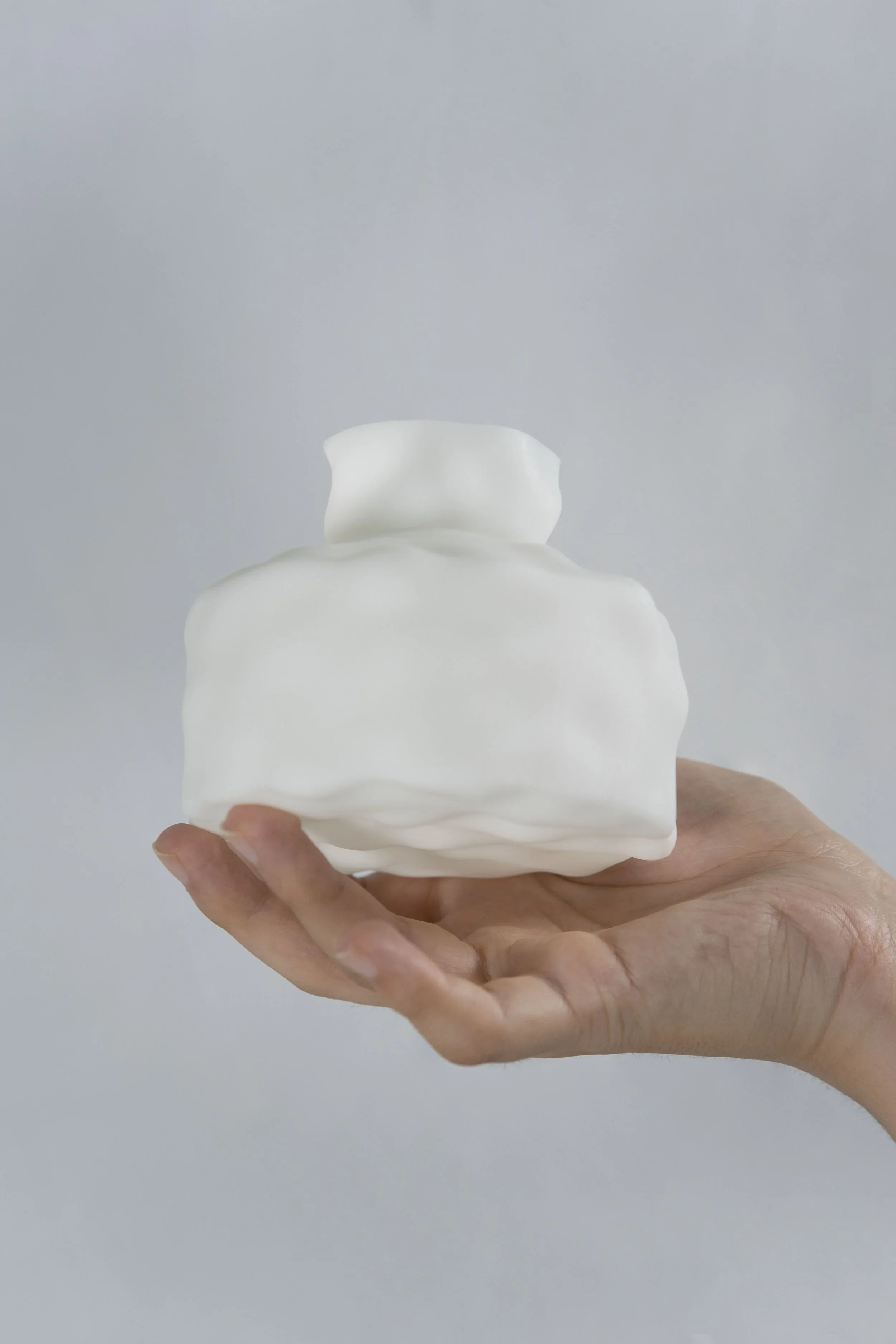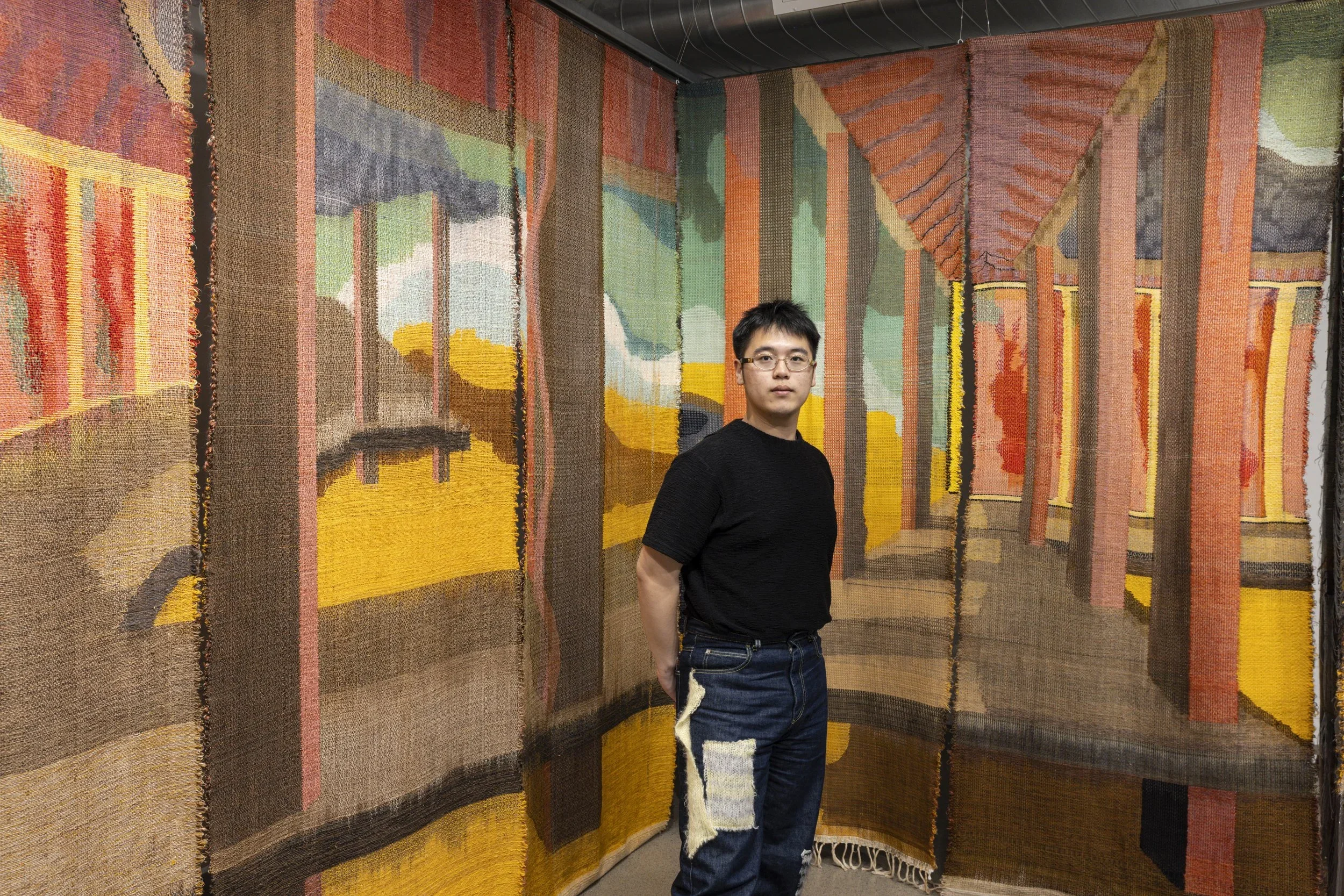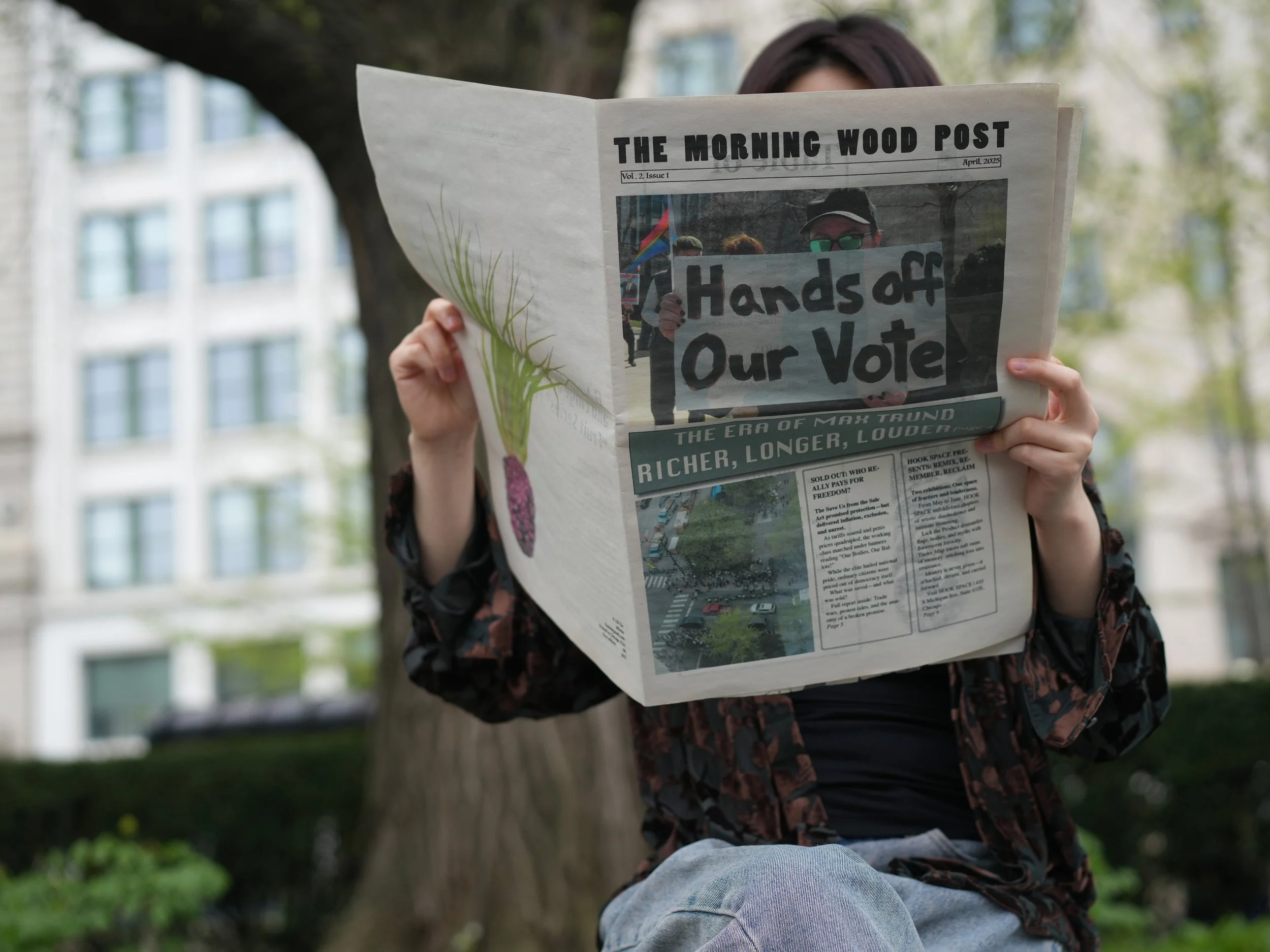10 Questions with Yuwen Huang
Al-Tiba9 Art Magazine ISSUE17 | Featured Artist
Yuwen Huang (b. 1997, Shenzhen, China; now based in San Francisco, CA) is a media artist who holds an MFA in Art & Technology/Sound Practice from the School of the Art Institute of Chicago. Her current focus lies at the intersection of blockchain technology and art, creating a critical dialogue to foster inclusivity and accessibility within the digital age art community. In 2019, she received a Bachelor of Arts in Intermedia Art from the China Academy of Art (CAA), and her work was longlisted for the Lumen Prize (UK) in the Crypto category in 2023. Most recently, her blockchain artwork was featured in the 2024 Ars Electronica Festival, The Wrong Biennale 2023/24, and was presented in the New Media Caucus Showcase as part of the College Art Association conference 2024. As an emerging curator, 21st Century Wanderer, which investigates the intersection of technology and walking, was selected by the Chicago Art Department for an exhibition in Nov 2024.
Yuwen Huang - Portrait
ARTIST STATEMENT
Yuwen works across video, internet, installation, GAN-generated images and videos, blockchain, and creative writing. Through the lens of technology, her art investigates the human relationship with society, the environment, and culture, exploring how these connections have been shaped by technology over time.
Influenced by various Eastern methods of spiritual cultivation, such as the I-Ching, she is concerned with understanding the spiritual essence and interconnectedness of all things and their profound connection to our inner experiences. Her work often includes virtuality presented in media, using it to reveal the unseen connections that underlie the material world.
For Yuwen, engaging with her surroundings is essential to her creative process, strengthening her connection to the physical world in an increasingly digital era. She seeks to uncover new potentials from both the real and virtual worlds, drawing on the past to present a vision for the future.
Public Artists Manifesto, Blockchain-based interactive websites, installation, 4 ipads,63 laser-engraved acrylic print, 3d printed objects, Dimensions Variable, 2024 © Yuwen Huang - Photo courtesy of Liang He
In-circle Series | Project Statement
The In-circle Series challenges participants to reflect on inclusivity and accessibility on the internet. The work houses two interactive websites built on smart contracts which run on the Ethereum Blockchain. It combines features of internet interaction, blockchain technology, and creative writing to expand and reshape our understanding of the artist's identity.
One of the works, Artist Poems, invites users to collaboratively define an artist's identity. It creates a real-time, collective manifesto of the public artist, while poetically liberating that identity through participant contributions. The creative writing portion draws inspiration from Alison Knowles' House of Dust (1966), a computer-generated poem. The work focuses on the blockchain's feature of permanence to document the audience's definitions of an artist literally. By leveraging the constraints and features of the Internet and blockchain, the artwork series calls to action in our ongoing efforts to achieve a more inclusive and equitable society in the digital era.
The physical work transforms audience interactions from the virtual online space into a continuously evolving public manifesto installation. The collected inputs from the Artist Poem database include the time when each audience defines the artist, a transaction hash number automatically generated on the blockchain as a record for each interaction, and the text resulting from audience participation. This work brings intangible and eternal data from the virtual network, along with the abstract concept of time—both past and present—into the space we are able to perceive and feel.
In-circle Series V2.0, Blockchain-based interactive websites, screens, frames, prints, tables, Dimensions Variable, 2024 © Yuwen Huang
AL-TIBA9 ART MAGAZINE ISSUE17
Get your limited edition copy now
INTERVIEW
How did your studies at the China Academy of Art and the School of the Art Institute of Chicago shape your approach to media art?
My studies at the China Academy of Art and the School of the Art Institute of Chicago (SAIC) have shaped my approach to media art by helping me develop both breadth and depth in my practice.
At the China Academy of Art, I explored various media such as VR, audio-visual art, photography, electronic installations, and 2D animation. Through this process, I gained an intuitive understanding of each medium's unique characteristics and its potential for artistic expression. I also realized that creative methods and presentation strategies vary significantly across media, which influenced how I chose the most suitable medium for each project. While my undergraduate studies provided me with a strong foundation in media art, they also made me aware of my limitations in conceptual development, which shaped my goals for further study.
At SAIC, I've been focusing on strengthening the conceptual aspects of my work. I've paid close attention to how I communicate my ideas, often discussing potential directions with my advisors to refine my approach. The creative freedom at SAIC has allowed me to experiment and understand that media artists can take many different paths and approaches. Personally, I aim to focus more on the core ideas and concepts behind my work rather than relying solely on visually rich expressions.Together, these experiences have shaped my dedication and passion for media art, providing me with both technical and conceptual tools to further develop my practice. I see this as just the beginning of my journey as an artist.
Artist Poem, Blockchain-based interactive website, 2 LCD computer monitors, a 50in TV monitor, Dimensions Variable, 2024 © Yuwen Huang - Photo courtesy of Mengjun Duan
Artist Poem (detail), 2024 © Yuwen Huang
How has moving from Shenzhen to Hangzhou, Chicago, and finally San Francisco influenced your perspective on art and technology?
I am always on the move, and I enjoy the unique experiences that each city offers. I grew up in Shenzhen, which is a fast-paced and innovative city known for its electronics markets. I guess that's why I developed a fascination with technology and an openness to innovation. But at the time, Shenzhen wasn't as focused on developing contemporary and digital art as it is now. I never imagined the possibilities of combining art and technology.
My perspective changed when I moved to Hangzhou to study at the China Academy of Art. That's when I discovered the art and technology major. From what I knew, Hangzhou was home to China's pioneering Department of New Media Art, set up by Zhang Peili, which later became the Department of Intermedia Art. I was fortunate to experience the vibrant energy and forward-thinking atmosphere of media art during my time there. Through various exhibitions and performances, I was able to gain a first-hand insight into the immense potential of the field and felt truly fortunate to be part of something that seemed to embody the future. This experience also prompted me to explore the history and development of media art in the West, where the discipline has deeper roots and foundations.
This curiosity ultimately led me to Chicago for graduate studies. Chicago is a city with a vibrant creative community that places great value on individuality. I am encouraged to explore the conceptual and expressive dimensions of technology in art. The multicultural environment of the city also provides rich resources to expand my understanding of the relationship between art, technology, and other disciplines and allows me to engage with them from new perspectives.
Now, I have moved to San Francisco, a city that is even more connected to emerging technology such as AI. I'm excited to see how this new environment will shape and inspire my understanding of art and technology.
What inspired your focus on blockchain technology and its potential in the art world?
I first came across blockchain art during my graduate studies. I'd like to thank Douglas Rosman, who introduced us at the art school to this emerging technology and related information. I was deeply intrigued by the distinctive characteristics and underlying logic of blockchain technology, which prompted me to consider the potential of combining this technology with conceptual art. Inspired by the concept of Rhea Myers' artwork Is Art (2014/2015), I was reminded of my previous feelings about my identity as an artist. It goes back to my second year of university when I first saw my name on an exhibition poster. Although I hadn't envisioned the project then, it sparked a lasting reflection on the concept of 'artist identity' and who has the power to define it, a question that has stayed with me. This is how my To Be an In-circle Artist came about. The thought process involved in creating it also gave me a deeper understanding of the potential of blockchain in the art world. The project transformed my ongoing struggles with artist identity into an unexpected piece of media art. It also fuelled my interest in using blockchain as a medium for artistic expression. I began to explore how the decentralized principles of blockchain could align with the democratization of art, creating an inclusive space where anyone could participate as an artist. The process unfolded naturally and provided me with new perspectives throughout my journey.
Circle Archive, 2023 © Yuwen Huang
You work across various media, from GAN-generated images to blockchain-based art. How do you decide which medium best suits each project?
The medium should serve the content – that's always been my view. In the past, I believed that the process would start with an idea, and then the most appropriate medium would be chosen based on how well a medium can convey the concept, which is crucial. One medium might only deliver 50% of the intended effect, while another might deliver 70%. This shows how important it is for the artist to choose the right medium.
But now I think the perfect match between medium and content isn't always a one-way decision, where the artist simplychooses the medium based on the idea. For example, when I discover a new medium, and I feel inspired to experiment with it, I'll often mentally sift through my pool of ideas to find the one that best fits the medium. I see this as a dynamic process – sometimes the idea leads, sometimes the medium does. Either way, it is essential to have a rich pool of ideas and techniques from which to draw in order to find the best match.
Physical interaction is central to your creative process. How do you incorporate this in a primarily digital art practice?
At first, the integration of physical interaction into my artwork wasn't something I had in mind. Later, however, I noticed that the US art market doesn't pay much attention to new media art, unlike Europe, where such exhibitions are more common. New media-only exhibitions are relatively rare in the US, so I started adding physical installation elements to my media-based works almost instinctively to better adapt to this environment. I believe this helps create more opportunities for audience interaction and makes it easier for them to connect with the context of my art.
My work doesn't always focus on visual stimulation. Instead, it often relies on technical concepts and logical frameworks as a core part of its expression. This may make it more challenging for a general audience to understand or engage with compared to traditional visual art. As an artist, I recognize the importance of adapting my work to different venues and audiences, making adjustments to improve how it is received and understood.
To be an in-circle artist, 2024 © Yuwen Huang
In circle series V1.0, 2024 © Yuwen Huang
Spiritual traditions like the I-Ching, which you mention in your statement, influence your art. Could you elaborate on this impact?
Ever since I was young, I've been really inspired by my mum's spiritual side, and I've always had a strong connection with Buddhism and Taoism. I've always been interested in understanding the complex relationships between different things and seeing the world as a connected whole. This perspective is particularly reflected in the cultural essence of the I Ching and the practices derived from it, such as Feng Shui and MeiHuaYiShu. At its core, it emphasizes the ability to perceive and connect with the unseen connections between all things, which can be defined as a kind of intuitive awareness of invisible relationships.
These influences have shaped both my consciousness and sensory perception, driving a strong desire to express these connections in my art. My early works, such as The TRUTH, were an exploration of these perceptions. I later came to realize that such themes are best conveyed indirectly, through the interplay of elements, rather than as stand-alone themes. This approach now forms the basis of my creative process.
In the In-Circle Series, for example, the circular arch serves as a gateway, originally inspired by a Chinese utopian garden, symbolizing a passage between the real world and an idealized virtual realm. It could be said that it represents the connection between the real and the virtual. Similarly, in Public Artist Manifesto, I explore the fluid nature of art and artist definitions by integrating audience participation. Their input and engagement are preserved as a digital record that is later reinterpreted into tangible forms in the physical world. This interplay reflects I Ching's philosophy of energy flow, a concept that has deeply influenced me.
As I continue to refine my approach, particularly in new media art, my aim is to clearly express the interconnectedness of the visible and invisible worlds and to reveal these relationships through the structure and logic of my creations.
Your work explores the relationship between humans, society, and technology. What key questions or ideas do you aim to address?
In my practice, I aim to open new ways of thinking for the audience, showing them connections that they might not have noticed before. The world is always changing. With new technology coming along all the time, there are lots of things in our current world that we can change or make people more aware of. There are also lots of assumptions and norms that people just take for granted, and I use my work to look closely at these ideas and challenge them.
Art, technology, and more. If I were to add a third word, I would not limit myself to choosing a third word to encompass the subjects I am interested in. Instead, I try to remain open to my evolving perceptions of the current era and society and my own responses to them. This approach allows me to explore questions about how we navigate the complex relationships between humans, society, and technology while also seeking to bridge the past with the present in innovative and meaningful ways.
Random Walk Memory, 2022 © Yuwen Huang
Your upcoming curatorial project, 21st Century Wanderer, examines technology and walking. Could you tell us more about the concept and your vision for this exhibition?
This project, which I have been preparing for over a year, is inspired by Lori Waxman's research on Walking Art. Walking is a way for societies and individuals to connect to their environment and their spirit. As societies change, especially with urbanization and the growth of technology, the way we think and feel about walking continues to evolve. Sometimes, this evolution happens without us even realizing it, as the power of technology gradually shapes our daily lives.
In the works of the artists I have invited, I see traces of these larger effects they might not even be fully aware of. Their exploration of walking and the use of technology reflects contemporary life, our connection to society, and how we can break free from conventional ways of interacting with the world, offering fresh and unexpected perspectives.
This exhibition shows how walking is both a tool for shaping the digital age and a reflective practice mirroring contemporary life. By intertwining the themes of walking and technology, it creates a cohesive narrative that bridges diverse artistic expressions. Through this lens, the exhibition aims to inspire a deeper appreciation for walking – a seemingly simple act with profound significance – and reveal its timeless relevance and vast potential for discovery in a world increasingly defined by technology.
Are there any new technologies or themes you’re eager to explore in future projects, and how do you envision your art evolving?
Right now, I'm looking into AI technology while also building on my knowledge of blockchain. In terms of themes, I'm looking to use technology as a way to express my understanding of traditional Chinese culture. I'm interested in exploring how traditional culture can merge with technology – not just visually but conceptually, through thoughtful reflection and processing. I will continue collecting ideas and themes, capturing fleeting thoughts in writing to revisit and develop when the timing and tools feel right. Beyond creating art, I also see curating as a meaningful way to explore and express my understanding of the relationships between technology, society, and the individual. Through different forms, I seek to expand my influence and reach. Ultimately, I aspire for my work to challenge perspectives and inspire others to see the world, their relationships, and themselves in new and meaningful ways.
Public Artist Manifesto (detail), 2024 © Yuwen Huang
Lastly, what is your take on the impact of AI on art? Do you view it as a threat or an opportunity?
The impact of AI on art is complex and multifaceted. It offers some great opportunities for innovation, but it also raises questions about authorship and creativity. From my perspective, I see AI as a powerful tool that can help artists experiment with new styles and explore ideas that might not be achievable through traditional methods. From chatting with friends about how they use AI in their creative work, I've found that AI not only broadens our perspectives but also deepens our understanding of the world around us.
While AI is developing fast and affecting many industries, seeing it as a "threat" often comes from a human-centric view. As highly intelligent beings, it's only natural for us to feel a bit uneasy when faced with a form of intelligence that seems to surpass our own abilities. However, From my own point of view, We have always coexisted with forces greater than ourselves. The real challenge lies in how we choose to engage with these tools and incorporate them into our lives in meaningful ways.
I believe that AI offers an opportunity to reconsider the conventional boundaries that have been in place. I am curious about the potential of AI to reinterpret traditional cultural elements, with the aim of creating works that focus on conceptual depth rather than just visual aesthetics.




























